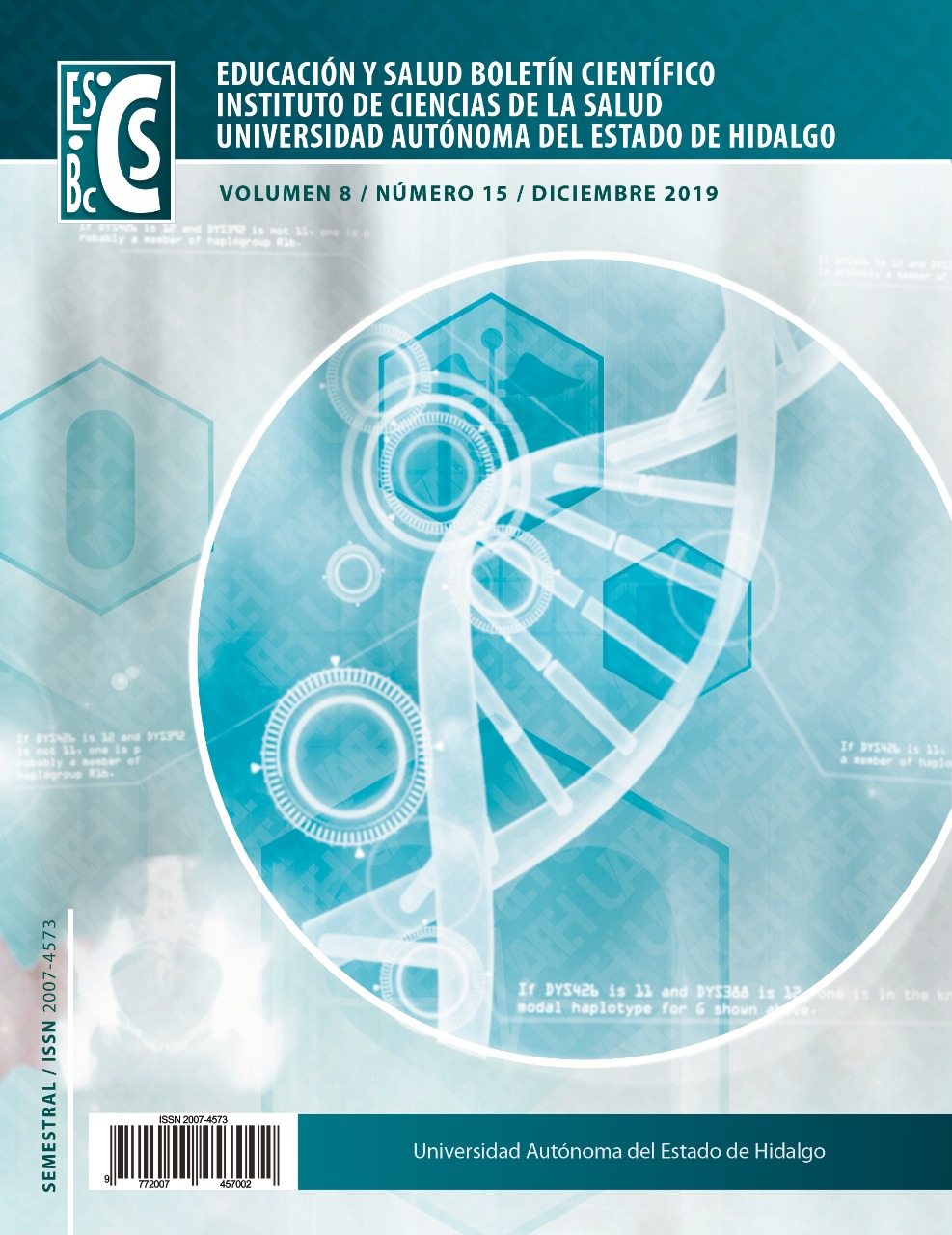El Microbioma Humano: Entre la salud y la enfermedad
DOI:
https://doi.org/10.29057/icsa.v8i15.4603Palabras clave:
Microbioma Humano, bacteria, genoma, salud, enfermedadResumen
El Proyecto del Microbioma Humano analizó y caracterizó a nivel genómico a las comunidades bacterianas asociadas con humanos. Por primera vez se han visualizado las relaciones entre seres humanos y microorganismos así como las variables y parámetros microbiológicos y clínicos que permitirán comprender mejor los trastornos originados por el microbioma.
Las interacciones cooperativas entre los microbios y huéspedes implican funciones elementales del hospedero, como la defensa, el metabolismo y la reproducción. La variación de la microbiota del hospedero se debe a la introducción o extinción de grupos microbianos particulares o por cambios en la estructura de su población. Por ejemplo, algunas investigaciones mostraron que la maduración funcional del microbioma intestinal durante los primeros tres años de vida es común en tres poblaciones de diferentes países, e incluyen cambios asociados a la edad con genes bacterianos implicados en la biosíntesis y el metabolismo de las vitaminas.
La desaparición, erradicación, desinfección o cualquier termino similar de forma selectiva de la microbiota podría contribuir a muchas de las enfermedades del sistema digestivo, predispondría a la obesidad y sus daños colaterales, favorecería el asma y trastornos relacionados, así como se incrementaría la propagación de epidemias de patógenos de alto riesgo. La futura investigación deberá tratar de aclarar y prevenir estos puntos, pues los fundamentos teóricos indican que los cambios ecológicos que involucren a nuestras microbiotas ancestrales podrían tener el poder de afectar bioquímica, inmunológica, fisiológica y hasta psíquicamente a nuestra salud.
Descargas
Información de Publicación
Perfiles de revisores N/D
Declaraciones del autor
Indexado en
- Sociedad académica
- N/D
Citas
B.W.B.,R.A.G.,S.K.H.,B.A.M.,K.E.N.,J.F.P.,G.M.W.,O.W.,R.K.W. Structure, function and diversity of the healthy human microbiome. Nature. 2012 June 14; 486: 207-214.
Cho I, Blaser J. The human microbiome: at the interface of health and disease. Nature Reviews. 2012 April; 13: 260-270.
Yatsunenko T, Rey F, Manary M, Trehan I, Domínguez-Bello M, Contreras M, et. Al. Human gut microbiome viewed across age and geography. Nature. 2012 June 14; 486: 222-228.
Qin J, Li R, Raes J, Arumugam M, Burgdorf K, Nielsen T, et. Al. A human gut microbial gene catalogue established by metagenomic sequencing. Nature. 2010 March 4; 464: 59-67.
Chen E, Fischbach M, Belkaid Y. Skin microbiota-host interactions. Nature. 2018 January 25; 553: 427-436.
Tett A, Pasolli E, Farina S, Truong, D, Asnicar F, Moreno Z, Beghini F, et. Al. Unexplored diversity and strain-level structure of the skin microbiome associated with psoriasis. Nature Partner Journals. 2017 June 22; 3 (14): 1-12.
Falush D, Kraft C, Taylor N, Correa P, Fox J, Achtman M, Suerbaum, S. Recombination and mutation during long-term gastric colonization by Helicobacter pylori: Estimates of clock rates, recombination size, and minimal age. PNAS. 2001 December 18; 98 (26): 15056-15061.
Tomb F, White O, Kerlvage A, Clayton R, Ketchum K, Fleischmann R, Klenk H, et. Al. The complete genome sequence of the gastric pathogen Helicobacter pylori. Nature. 1997 August; 388: 539-547.
Linz B, Balloux F, Moodley Y, Manica A, Liu H, Roumgnac P, et. Al. An African origin for the intimate association between humans and Helicobacter pylori. Nature. 2007 February 22; 22: 915-918.
Qin N, Yang F, Li A, Prifti E, Chen Y, Shao J, et. Al. Alterations of the human gut microbiome in liver cirrosis. Nature. 2014 September 4; 513: 59-77.
Serena C, Ceperuelo-Mallafré V, Keiran N, Queipo-Ortuño M, Bernal R, Gomez-Huelgas R. Elevated circulating levels of succinate in human obesity are linked to specific gut microbiota. The ISME Jorunal. 2018 January 12. Disponible en: http://www.nature.com/articles/s41396-018-0068-2 [aprox. 16 págs].
Jie Z, Xia H, Zhong S, Feng Q, Li S, Liang S, et. Al. The gut microbiome in atherosclerotic cardiovascular disease. Nature communications. 2017; 8 (845): 1-12.
Subramanian S, Huq S, Yatsunenko T, Haque R, Alam M, Benezra A, Mahfuz M, et. Al. Persistent gut microbiota immaturity in malnourished Bangladeshi children. Nature. 2014 June 19; 510: 417-421.
Turnbaugh P, Hamady M, Yatsunenko T, Cantarel B, Duncan A, Ley R, et. Al. A core gut microbiome in obese and lean twins. Nature. 2009 January 22; 457: 480-485.
Bäckhed F, Tremaroli V. Functional interactions between the gut microbiota and host metabolism. Nature. 2012 September 12; 489: 242-249.
Bosscher D, Chung W, Duncan S, Flint H, Luois, P, Parkhill J, Walker A. Modulation of the human gut microbiota by dietary fibres occurs at the species level. BioMed Central. 2016; 14 (3): 1-13.
Gordon J, Jansson J, Knight R, Lozupone C, Strombaugh J. Diversity, stability and resilience of the human gut microbiota. Nature. 2012 September 13; 489: 220-230.
Elson C, Hatton R, Maynard C, Weaver C. Reciprocal interactions of the intestinal microbiota and immune system. Nature. 2012 September 13; 489: 231-241.
Shanahan F, O’ Toole P. Host–microbe interactions and spatial variation of cancer in the gut. Nature Reviews. 2014 June 24.
Blaser M, Falkow S. What are the consequences of the disappearing human microbiota? Nature Reviews. 2009 December; 7: 887-894.
Brandwein M, Steinberg D and Meshner S. Microbial biofilms and the human skin microbiome. NPJ Biofilms and Microbiomes. 2016 November 23; 2: 1-6
Drewes JL et al. High-resolution bacterial 16S rRNA gene profile meta-analysis and biofilm status reveal common colorectal cancer consortia. NPJ Biofilms and Microbiomes. 2017 November 29; 3: 34
Shukla SD, Budden KF, Neal R and Hansbro PM. Microbiome effects on immunity, health and disease in the lung. Clinical & Translational Immunology. 2017 February 5. 6, e133.
Vandeputte D, Kathagen G, et al. Quantitative microbiome profiling links gut community variation to microbial load. Nature. 2017 November 23; 551: 507-511.
Proctor L. What´s next for the human microbiome?. Nature. 2019 May 30; 569: 623-625.



















